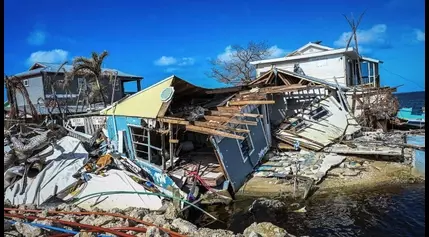
Riding the Storm: Investors Flock to Catastrophe Bonds as Natural Disasters Intensify
As the world grapples with the escalating threat of natural disasters, a new investment opportunity has emerged that is capturing the attention of savvy investors. Catastrophe bonds, once a niche financial instrument, have become the best-performing alternative asset class, delivering a remarkable 20% return in 2023. With a new exchange-traded fund (ETF) on the horizon, the accessibility and appeal of these high-yield bonds are set to reach new heights.Unlocking the Potential of Catastrophe Bonds: A Diversification Powerhouse
Weathering the Storm: Catastrophe Bonds Outshine the Competition
The catastrophe bond market has been a standout performer, outpacing traditional asset classes and alternative investments alike. In 2023, these bonds delivered a staggering 20% return, more than doubling the average hedge fund's performance and quadrupling the gains of private equity buyout funds. This remarkable success can be attributed to the unique characteristics of catastrophe bonds, which offer investors a chance to earn robust returns while providing insurers with a means to hedge against the financial impact of natural disasters.Diversification Redefined: The Uncorrelated Advantage of Catastrophe Bonds
One of the key appeals of catastrophe bonds is their ability to provide genuine diversification to investment portfolios. Unlike stocks and traditional bonds, the performance of these instruments is not tied to economic cycles or market fluctuations. Hurricanes, earthquakes, and other natural disasters operate independently of the stock market, making catastrophe bonds a true diversifier. This uncorrelated nature has proven invaluable, as the asset class has demonstrated resilience even during periods of market turmoil, such as the 2008 financial crisis and the COVID-19 pandemic.Navigating the Risks: Catastrophe Bonds' Unique Challenges and Rewards
Investing in catastrophe bonds is not without its challenges, however. Unlike traditional fixed-income securities, these bonds face a unique set of risks, including the literal and figurative "lightning risk" of natural disasters. By the time a hurricane is forecast or a tornado touches down, it's often too late for investors to retreat. Yet, this very risk also presents a significant opportunity, as catastrophe bonds offer yields in the "mid to high teens," while the expected loss rate for a broad portfolio is just "two to three percent." This discrepancy in returns is a testament to the premium investors are willing to pay to access the diversification and high-yield potential of these specialized instruments.The Expanding Catastrophe Bond Market: Riding the Wave of Growth
The catastrophe bond market has experienced remarkable growth since its inception, with .4 billion in outstanding bonds as of today. The momentum is accelerating, with .7 billion worth of bonds issued so far in 2023, putting the market on track to shatter the full-year record of .4 billion set in 2023. This rapid expansion reflects the growing demand for these specialized instruments, as insurers and investors alike recognize the value they offer in managing the financial risks associated with natural disasters.Bridging the Gap: The Arrival of a Catastrophe Bond ETF
Until now, accessing the catastrophe bond market has been a challenge for many investors, with limited options available. Mutual funds and private wealth accounts have provided some exposure, but the introduction of a dedicated catastrophe bond ETF promises to revolutionize the landscape. The proposed Brookmont Capital Management ETF, with the potential ticker "ROAR," aims to make investing in these high-yield bonds more accessible and straightforward than ever before.Navigating the Liquidity Challenge: Overcoming the Hurdles of an Illiquid Asset
One of the primary concerns surrounding the launch of a catastrophe bond ETF is the issue of liquidity. Catastrophe bonds are notoriously illiquid, making it challenging for ETFs to quickly acquire and dispose of the assets. To address this, Brookmont Capital Management has partnered with a well-established sub-advisor in the catastrophe bond space, leveraging their expertise and deal-flow capabilities to ensure the ETF can effectively source the necessary investments. Additionally, the fund's prospectus indicates that it will invest in a variety of related instruments, such as other insurance-linked securities and insurers' corporate bonds, to provide investors with immediate, if imperfect, exposure until the fund can secure the desired catastrophe bonds.Weathering the Storm: Preparing for the Unpredictable
As the catastrophe bond ETF prepares to launch on September 25th, a date that is not coincidental, investors must be mindful of the inherent volatility and unpredictability of the underlying assets. The University of South Carolina's Robert Hartwig cautions prospective buyers to scrutinize the ETF's holdings "with a fine-tooth comb" upon release, ensuring there is no excessive exposure to specific events or regions. Investors should also be prepared for the ETF's price to "fluctuate with the weather," as the performance of catastrophe bonds is inextricably linked to the occurrence and severity of natural disasters.In a world where the frequency and intensity of natural disasters are on the rise, the appeal of catastrophe bonds as a diversification tool and high-yield investment opportunity is undeniable. The impending launch of a dedicated ETF promises to make these specialized instruments more accessible to a wider range of investors, opening up new avenues for portfolio optimization and risk management. As the storm clouds gather, savvy investors are poised to ride the wave of growth in the catastrophe bond market, weathering the unpredictable forces of nature with a steadfast commitment to diversification and resilience.New

Entertainment

Entertainment

















